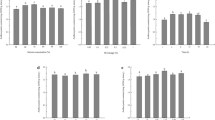Abstract
This study investigates the carbohydrate-hydrolyzing inhibitory potential of blueberry extract on carbohydrate-hydrolyzing enzymes and evaluates if the inhibitory activity is proanthocyanidin (PAC) or lower molecular weight phenolic dependent. Freeze-dried blueberry powder was extracted using acetone and subjected to C18 extraction (BAE). Low-molecular weight phenolics (BAE-LMW) and PACs (BAE-PAC) were separated from BAE with gel filtration chromatography using LH-20 column. Total phenolic content, PAC content, and phenolic profiles using HPLC, as well as rat α-glucosidase, sucrase, and maltase inhibitory activities, were determined for all samples. The rat alpha-glucosidase inhibitory activity of BAE (IC50 0.390 mg/mL TP basis) was enhanced in BAE-LMW (IC50 0.242 mg/mL TP basis) and reduced in BAE-PAC (IC50 0.915 mg/mL TP basis). Similar trends were observed with maltase and sucrase inhibitory activities. Our findings suggest that blueberry acetone extract has inhibitory activity on carbohydrate-hydrolyzing enzymes and this effect is dependent on LMWs rather than PAC.









Similar content being viewed by others
References
Adams LS, Phung S, Yee N, Seeram NP, Li L, Chen S (2010) Blueberry phytochemicals inhibit growth and metastatic potential of MDA-MB-231 breast cancer cells through modulation of the phosphatidylinositol 3-kinase pathway. Cancer Res 70:3594–3605
American Diabetes Association (2013a) Economic costs of diabetes in the U.S. in 2012. Diabetes Care 36:1033–1046
American Diabetes Association (2013b) Diagnosis and classification of diabetes mellitus. Diabetes Care 36:S67–S74
Apostolidis E, Li L, Kang B, Lee C, Seeram N (2012) Seasonal influence on phenolic-mediated antihyperglycemic properties of Canadian sugar and red maple leaves using in vitro assay models. Food Sci Biotechnol 21:753–760
Basu A, Du M, Leyva MJ, Sanchez K, Betts NM, Wu M, Aston CE, Lyons TJ (2010) Blueberries decrease cardiovascular risk factors in obese men and women with metabolic syndrome. J Nutr 140:1582–1587
Castrejón ADR, Eichholz I, Rohn S, Kroh LW, Huyskens-Keil H (2008) Phenolic profile and antioxidant activity of highbush blueberry (Vaccinium corymbosum L.) during fruit maturation and ripening. Food Chem 109:564–572
Centers for Disease Control and prevention (2013) Diagnosed and undiagnosed diabetes in the United States, all ages, 2010. http://www.cdc.gov/diabetes/pubs/estimates11.htm. Accessed December 2013
Demiray S, Pintado ME, Castro PML (2009) Evaluation of phenolic profiles and antioxidant activities of Turkish medicinal plants: Tilia argentea, Crataegi folium leaves and Polygonum bistorta roots. World Acad Sci Eng Technol 30:307–312
Gavrilova V, Kajdzanoska M, Gjamovski V, Stefova M (2011) Separation, characterization and quantification of phenolic compounds in blueberries and red and black currents by HPLC-DAD-ESI-MSn. J Agric Food Chem 59:4009–4018
Grace MH, Ribnicky DM, Kuhn P, Poulev A, Logendra S, Yousef GG, Raskin I, Lila MA (2009) Hypoglycemic activity of a novel anthocyanin-rich formulation from lowbush blueberry, Vaccinium angustifolium Aiton. Phytomedicine 16:406–415
Gu L, Kelm MA, Hammerstone JF, Beencher G, Holden J, Haytowitz D, Prior RL (2003) Screening of foods containing proanthocyanidins and their structural characterization using LC-MS/MS and thiolytic degradation. J Agric Food Chem 51:7513–7521
Hanefeld M (2007) Pioglitazone and sulfonylureas: effectively treating type 2 diabetes. Int J Clin Pract 61:20–27
Hellstrom J, Sinkkonen J, Karonen M, Mattila P (2007) Isolation and structure encidation of procyanidin oligomers from Saskatoon berries (Amelanchier alnifolia). J Agric Food Chem 55:157–164
U.S. High Bluberry Council (2012) Where blueberries grow. http://www.blueberrycouncil.org/blueberry-facts/where-blueberries-grow/. Accessed April 2012
Jarkko KH, Pirjo HM (2008) HPLC determination of extractable and unextractable Proanthocyanidins in plant materials. J Agric Food Chem 56:7617–7624
Kang BH, Racicot K, Pilkenton SJ, Apostolidis E (2014) Evaluation of the in vitro anti-hyperglycemic effect of Cinnamomum cassia derived phenolic phytochemicals, via carbohydrate hydrolyzing enzyme inhibition. Plant Foods Hum Nutr. doi:10.1007/s11130-014-0415-z
Krentz AJ, Bailey CJ (2005) Oral antidiabetic agents: current role in type 2 diabetes mellitus. Drugs 65:385–411
Kwon Y-I, Vattem DA, Shetty K (2006) Clonal herbs of Lamiaceae species against diabetes and hypertension. Asia Pac J Clin Nutr 15:107–118
Kwon Y-I, Apostolidis E, Kim Y-C, Shetty K (2007) Health benefits of traditional corn, beans and pumpkin; in vitro studies for hyperglycemia and hypertension management. J Med Foods 10:266–275
Lee J (2013) Proanthocyanidin A2 purification and quantification of American cranberry (Vaccinium macrocarpon Ait.) products. J Funct Foods 5:144–153
Paul S, Rimando AM, Lee HJ, Ji Y, Reddy BS, Suh NJ (2009) Anti-inflammatory action of pterostilbene is mediated through the p38 MAPK pathway in colon cancer cells. Cancer Prev Res (Phila) 2:650–657
Roopchard DE, Kuhn P, Rojo LE, Lila MA, Raskin I (2012) Blueberry polyphenol-enriched soybean flour reduces hyperglycemia, body weight gain and serum cholesterol in mice. Pharmacol Res 68:59–67
Strik BC, Yarborough D (2005) Blueberry production trends in North America, 1992 to 2003, and predictions for growth. Horttechnology 15:391–398
Wang SY, Chen CT, Sciarappa W, Wang CY, Camp MJ (2008) Fruit quality, antioxidant capacity, and flavonoid content of organically and conventionally grown blueberries. J Agric Food Chem 56:5788–5794
Wang SY, Camp MJ, Ehlenfeldt MK (2012) Antioxidant capacity and α-glucosidase inhibitory activity in peel and flesh of blueberry (Vaccinium spp.) cultivars. Food Chem 132:1759–1768
World Health Organization (2013) Fact sheet no 312. http://www.who.int/mediacentre/factsheets/fs312/en/index.html. Accessed December 2013
Acknowledgments
This research was funded by the 6.2 Applied Research project area “Technologies for Nutrient/Novel Delivery Systems” from the NSRDEC Combat Feeding Directorate.
Author information
Authors and Affiliations
Corresponding author
Rights and permissions
About this article
Cite this article
Kang, BH., Racicot, K., Pilkenton, S.J. et al. Blueberry extract inhibits carbohydrate-hydrolyzing enzymes and these inhibitory activities are not proanthocyanidin dependent. J Korean Soc Appl Biol Chem 58, 127–136 (2015). https://doi.org/10.1007/s13765-015-0001-6
Received:
Accepted:
Published:
Issue Date:
DOI: https://doi.org/10.1007/s13765-015-0001-6




